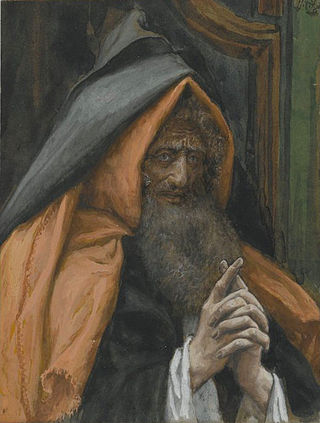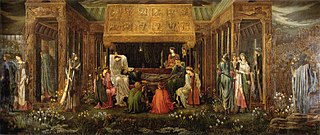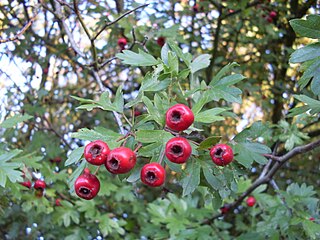
The Holy Grail is a treasure that serves as an important motif in Arthurian literature. Various traditions describe the Holy Grail as a cup, dish, or stone with miraculous healing powers, sometimes providing eternal youth or sustenance in infinite abundance, often guarded in the custody of the Fisher King and located in the hidden Grail castle. By analogy, any elusive object or goal of great significance may be perceived as a "holy grail" by those seeking such.

Joseph of Arimathea is a Biblical figure who assumed responsibility for the burial of Jesus after his crucifixion. Three of the four canonical Gospels identify him as a member of the Sanhedrin, while the Gospel of Matthew identifies him as a rich disciple of Jesus. The historical location of Arimathea is uncertain, although it has been identified with several towns. A number of stories about him developed during the Middle Ages.

Glastonbury is a town and civil parish in Somerset, England, situated at a dry point on the low-lying Somerset Levels, 23 miles (37 km) south of Bristol. The town had a population of 8,932 in the 2011 census. Glastonbury is less than 1 mile (2 km) across the River Brue from Street, which is now larger than Glastonbury.

Avalon is a mythical island featured in the Arthurian legend. It first appeared in Geoffrey of Monmouth's 1136 Historia Regum Britanniae as a place of magic where King Arthur's sword Excalibur was made and later where Arthur was taken to recover from being gravely wounded at the Battle of Camlann. Since then, the island has become a symbol of Arthurian mythology, similar to Arthur's castle of Camelot.

Crataegus, commonly called hawthorn, quickthorn, thornapple, May-tree, whitethorn, Mayflower or hawberry, is a genus of several hundred species of shrubs and trees in the family Rosaceae, native to temperate regions of the Northern Hemisphere in Europe, Asia, North Africa and North America. The name "hawthorn" was originally applied to the species native to northern Europe, especially the common hawthorn C. monogyna, and the unmodified name is often so used in Britain and Ireland. The name is now also applied to the entire genus and to the related Asian genus Rhaphiolepis.

The cherry blossom, or sakura, is the flower of trees in Prunus subgenus Cerasus. Sakura usually refers to flowers of ornamental cherry trees, such as cultivars of Prunus serrulata, not trees grown for their fruit. Cherry blossoms have been described as having a vanilla-like smell, which is mainly attributed to coumarin.

Glastonbury Abbey was a monastery in Glastonbury, Somerset, England. Its ruins, a grade I listed building and scheduled ancient monument, are open as a visitor attraction.

According to the New Testament, a woven crown of thorns was placed on the head of Jesus during the events leading up to his crucifixion. It was one of the instruments of the Passion, employed by Jesus' captors both to cause him pain and to mock his claim of authority. It is mentioned in the gospels of Matthew, Mark and John, and is often alluded to by the early Church Fathers, such as Clement of Alexandria, Origen and others, along with being referenced in the apocryphal Gospel of Peter.

Crataegus monogyna, known as common hawthorn, whitethorn,one-seed hawthorn, or single-seeded hawthorn, is a species of flowering plant in the rose family, Rosaceae. It grows to about 10 metres tall, producing hermaphrodite flowers in late spring. The berry-like pomes contain a stone-encased seed.

The Chalice Well, also known as the Red Spring, is a well situated near the summit of Chalice Hill, a small hill next to Glastonbury Tor in Glastonbury, Somerset, England. The natural spring and surrounding gardens are owned and managed by the Chalice Well Trust, founded by Wellesley Tudor Pole in 1959.

Appleton Thorn is a village in the borough of Warrington in Cheshire, England.

Prunus serrulata or Japanese cherry is a species of cherry tree that grows naturally in Japan, China, Korea, Vietnam, Taiwan, Laos, Myanmar, Thailand, Cambodia, India, Bangladesh, Bhutan, Nepal, Sri Lanka, Pakistan, Philippines, Malaysia, Indonesia, Brunei, Mongolia, Siberia, Papua New Guinea and into the Cape York Peninsula in north Queensland (Australia). The term also refers to a cultivar produced from Prunus speciosa, a cherry tree endemic in Japan. Historically, the Japanese have developed many cultivars by selective breeding of cherry trees, which are produced by the complicated crossing of several wild species, and they are used for ornamental purposes all over the world. Of these, the cultivars produced by complex interspecific hybrids based on the Oshima cherry are also known as the Cerasus Sato-zakura Group.

A Glastonbury Romance was written by John Cowper Powys (1873–1963) in rural upstate New York and first published by Simon and Schuster in New York City in March 1932. An English edition published by John Lane followed in 1933. It has "nearly half-a-million words" and was described as "probably the longest undivided novel in English".
Thomas Hughes was an English lawyer and dramatist.
Richard Broughton, alias Rouse, was a Catholic priest and antiquarian.

Grafting or graftage is a horticultural technique whereby tissues of plants are joined so as to continue their growth together. The upper part of the combined plant is called the scion while the lower part is called the rootstock. The success of this joining requires that the vascular tissues grow together. The natural equivalent of this process is inosculation. The technique is most commonly used in asexual propagation of commercially grown plants for the horticultural and agricultural trades. The scion is typically joined to the rootstock at the soil line; however, top work grafting may occur far above this line, leaving an understock consisting of the lower part of the trunk and the root system.

James Montague was an English bishop.

Described as "one of the most ambitious parish churches in Somerset", the present Church of St John the Baptist in Glastonbury, Somerset, England, dates from the 15th century and has been designated as a Grade I listed building.
The Prophecy of Melkin is a medieval text about an alleged hidden grave of Joseph of Arimathea at Glastonbury in England, containing the Holy Grail. It is contained in a local chronicle written by John of Glastonbury in the mid-14th century, who attributes it to an alleged Celtic bard named Melkin, said to have lived "before Merlin". It is thought to have been created in the context of legends that linked Joseph of Arimathea with the mythical Avalon, Glastonbury and the court of King Arthur, which had arisen in England in the mid-13th century.

Vaughan Cornish was an English geographer.


















